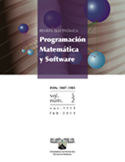Un enfoque genético cooperativo para el cálculo de trayectorias de los dedos de una mano robótica
DOI:
https://doi.org/10.30973/progmat/2014.6.2/4Palabras clave:
metaheurísticas, algoritmo genético, sujeción de objetos, robóticaResumen
En este artículo se presenta la aplicación de un algoritmo genético cooperativo para el cálculo de trayectorias que los dedos de una mano robótica configurable deben seguir para sujetar un objeto en dos dimensiones. A partir de un objetivo común, se establece el conjunto de movimientos coordinados para alcanzar la meta. Se describen las características de la sujeción de objetos, que involucra tanto la determinación de los puntos de contacto como la definición de las trayectorias de los dedos para alcanzar dichos puntos. Además de los algoritmos para la sujeción y para las trayectorias, se muestran los resultados experimentales
Citas
Mishha, B., Silver, N. Some discussion of static gripping and its stability. IEEE Transactions on Systems, Man and Cybernetics. 1989, 19 (1), 783-796. https://doi.org/10.1109/21.35342
Kerr, J., Roth, B. Analysis of multifingered hand. International Journal of Robotics Research. 1989, 4 (4), 3-17. https://doi.org/10.1177/027836498600400401
Han, L., Trinkle, J. C., Li, Z. X. Grasp analysis as linear matrix inequality problems. IEEE Transactions on Robotics and Automation. 2000, 16 (6), 663-674. https://doi.org/10.1109/70.897778
Michelman, P. Precision object manipulation with a multifingered robot hand. IEEE Transactions on Robotics and Automation. 1998, 14 (1), 105-113. https://doi.org/10.1109/70.660851
Muñoz, L. A., Bard, C., Nájera, J. A. Dexterous manipulation: A geometrical reasoning point of view. Proceedings of the 1995 International Conference on Robotics and Automation (ICRA). 1995, (1), 458-463. https://doi.org/10.1109/ROBOT.1995.525326
Bicchi, A. Hands for dexterous manipulation and robust grasping: A difficult road toward simplicity. IEEE Transactions on Robotics and Automation. 2000, 16 (6), 652-662. https://doi.org/10.1109/70.897777
Overgaard, L., Nelson, B. J., Khosla, P. K. A multiagent framework for grasping using visual servoing and collision avoidance. Proceedings of the 1996 International Conference on Robotics and Automation (ICRA). 1996, (3), 2456-2461. https://doi.org/10.1109/ROBOT.1996.506532
Muñoz, L.A., Doersam, Th. Simple Object Manipulation with dexterous hands. IFAC – International Conference of Industrial Systems. Belfort, France, 20-22 May 1997.
Michalewicz, Z., Michalewicz, M. Evolutionary Computation, techniques and their Applications. Proceedings of the 1997 IEEE International Conference on Intelligent Processing Systems (ICIPS’97). 1997, (1), 14-25. https://doi.org/10.1109/ICIPS.1997.672732
De la Cueva, V., Ramos, F. Cooperative genetic algorithms: a new approach to solve the path planning problem for cooperative robotic manipulators sharing the same work space. Proceedings of IEEE/RSJ International Conference on Intelligent Robots and Systems. 1998, (1), 267-272. https://doi.org/10.1109/IROS.1998.724630
Ponce, J., Sullivan, S., Sudsang, A., Boissonnat, J.D., Merlet, J.P. On computing four-finger equilibrium and force-closure grasps of polyhedral objects. International Journal of Robotics Research. 1997, 16 (1), 11-35. https://doi.org/10.1177/027836499701600102
Teichmann, M. Grasping and fixturing. Tesis doctoral. New York: New York University, 1995.
Liu, Y. H. Qualitative test and force optimization of 3-D frictional form-closure grasps using linear programming. IEEE Transactions on Robotics and Automation. 1999, 15 (1), 163-173. https://doi.org/10.1109/70.744611
Gill, M.A., Zomaya, A.Y. Obstacle voidance in multi-robot systems: Experiments in parallel genetic algorithms. World Scientific Publishing, 1998.
Mazer, E., Ahuactzin, J.M., Bessiere, P. The Ariadne’s clew algorithm. Journal of Artificial Intelligence Research (JAIR). 1998, 9, 295-316. https://doi.org/10.1613/jair.468
Descargas
Publicado
Cómo citar
Número
Sección
Licencia
Derechos de autor 2014 Rafael Rivera López, Fernando Ramos Quintana , Luis Alberto Muñoz Ubando

Esta obra está bajo una licencia internacional Creative Commons Atribución 4.0.
Usted es libre de:
 |
Compartir — compartir y redistribuir el material publicado en cualquier medio o formato. |
 |
Adaptar — combinar, transformar y construir sobre el material para cualquier propósito, incluso comercialmente. |
Bajo las siguientes condiciones:
 |
Atribución — Debe otorgar el crédito correspondiente, proporcionar un enlace a la licencia e indicar si se realizaron cambios. Puede hacerlo de cualquier manera razonable, pero de ninguna manera que sugiera que el licenciador lo respalda a usted o a su uso. |
| Sin restricciones adicionales: no puede aplicar términos legales o medidas tecnológicas que restrinjan legalmente a otros a hacer cualquier cosa que permita la licencia. |










